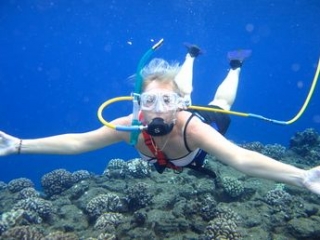The number of people practising underwater activities has progressively increased in recent years. The inclusion of women in all sporting fields has led to a strong female presence in the diving environment. This activity poses no health risks if standard safety measures – typically well-researched and defined – are followed.

Practically all studies underpinning safety standards and measures have used male subjects. But do these standards apply equally to women?
It’s important to note that female physiology differs from male physiology in certain aspects. A woman’s condition can change according to her menstrual cycle and potential pregnancy. In this article, we’ll address these questions based on the most current scientific knowledge available.

From a diving-related perspective, the fundamental difference between men and women lies in women’s lower body mass and distinct body composition. Theoretically, lower mass and reduced fat percentage have three key implications:
- Greater buoyancy
- Lower consumption of inhaled gases
- Higher capacity for inert gas storage (e.g., nitrogen), which accumulates in fatty tissue and forms bubbles during pressure changes – the primary gas responsible for decompression sickness.
Beyond these differences, current studies using Doppler techniques (which measure bubble volume/quantity from decompression and resulting symptoms) show no significant variation between sexes.
The higher inert gas storage may be offset by women’s lower gas consumption. For this or other reasons, leading scientific bodies confirm that women face no greater risk than men when following standard safety protocols.
Pregnancy and Diving
Special circumstances like pregnancy change this dynamic. Clearly defined risk factors exist, particularly during the first trimester when foetal organ development is highly vulnerable to hostile environments.

During this period, pressure changes and increased concentration/partial pressure of respiratory gases can be dangerous. Additionally, the foetus lacks a pulmonary filter to safely process decompression microbubbles, as foetal blood bypasses the lungs via the umbilical artery/placenta.
Lab studies on animals show decompression causes foetal malformations even when mothers remain unharmed. Human studies are limited to accidental cases (often where pregnancy was unknown), with no proven injuries or deformities.

Other pregnancy-related symptoms can complicate or prevent diving:
Fluid retention may cause equalisation difficulties by narrowing sinus/ear canals. Morning sickness also increases drowning risk through impaired underwater breathing.
Expert recommendations for pregnant women are unanimous:
- Surface water activities and shallow freediving pose minimal risk.
- Avoid prolonged breath-hold diving or gas-assisted dives. Accidental exposures don’t warrant pregnancy termination, as no proven side effects exist.
After vaginal birth, wait 3-4 weeks before resuming diving to prevent infections and allow physical recovery. Post-caesarean, assess wound healing – typically requiring ~8 weeks’ abstinence.

Breastfeeding
Diving isn’t contraindicated during lactation if the mother’s health permits. Schedule dives around feeds to avoid infant malnutrition and breast discomfort. Pressure changes don’t affect milk production, and no evidence suggests microbubbles enter milk or harm infants.

Post-dive nipple hygiene is critical to prevent bacterial contamination (potentially causing infant GI issues or maternal mastitis – treated with antibiotics).
Menstruation and Diving
No special restrictions apply, though PMS symptoms (mood swings, fatigue, joint pain, reduced focus) may warrant easier, decompression-free dives. Tampon use underwater isn’t considered risky.
Breast Implants
Modern implants use only silicone or saline (rapeseed oil was discontinued). Hyperbaric chamber tests show recreational dives cause nitrogen absorption/bubble formation in non-implanted prosthetics, but no rupture risks. Saline implants absorb less nitrogen than silicone.
Those with implants should consult their surgeon regarding diving, accounting for buoyancy changes based on implant volume, type, and placement.













